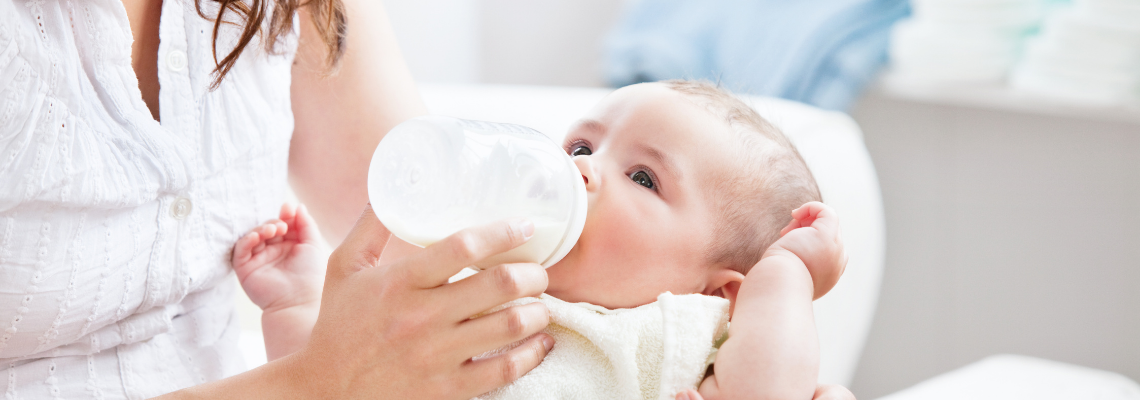
While all babies are unique, they all must eat. Therefore, it’s important to understand proper bottle-feeding positions.
Both breastfed and formula-fed infants eventually drink from bottles. Whether new parents exclusively use bottles or use them for convenience, knowing how to feed your baby is essential to their nourishment. Here are common feeding positions to try, especially for new parents.
Common Bottle-Feeding Positions
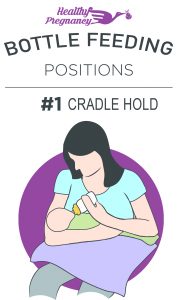 One of the most popular ways to bottle feed is in the cradling position. Start by placing your baby’s head in the fold of your arm with your other arm around or underneath their body for support. Tilt the arm with your baby’s head slightly upward so their body is slightly upright. It’s important to keep the head elevated in this position to prevent baby from being in a laying down position which allows formula or breastmilk to leak into their ear and can lead to an infection. The one downside to this feeding position is that it can be a workout for the parent and after 10 to 20 minutes of feeding your arm can become very tired.
One of the most popular ways to bottle feed is in the cradling position. Start by placing your baby’s head in the fold of your arm with your other arm around or underneath their body for support. Tilt the arm with your baby’s head slightly upward so their body is slightly upright. It’s important to keep the head elevated in this position to prevent baby from being in a laying down position which allows formula or breastmilk to leak into their ear and can lead to an infection. The one downside to this feeding position is that it can be a workout for the parent and after 10 to 20 minutes of feeding your arm can become very tired.
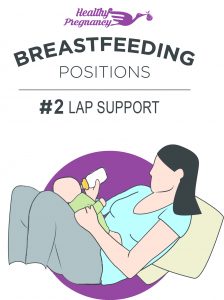 If you’re sitting or lying down, you can feed your little one with the added help of lap support. With your knees propped up, place your baby’s head at the top of your knees, their back supported against your thighs, and their feet on your stomach. This feeding position is great for bonding because it allows you to make eye contact while they eat. You can even multitask since your arms and at least one hand are free.
If you’re sitting or lying down, you can feed your little one with the added help of lap support. With your knees propped up, place your baby’s head at the top of your knees, their back supported against your thighs, and their feet on your stomach. This feeding position is great for bonding because it allows you to make eye contact while they eat. You can even multitask since your arms and at least one hand are free.
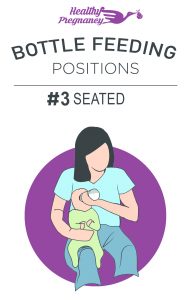 If your baby has acid reflux or gas, consider using the sitting position. Place your baby upright so the back of their head is touching your chest. You can also rest their head in the fold of your arm.
If your baby has acid reflux or gas, consider using the sitting position. Place your baby upright so the back of their head is touching your chest. You can also rest their head in the fold of your arm.
*Feeding Tip: For those trying to prevent reflux or gas, make sure the nipple is filled with milk before your baby takes a sip. If left unfilled, your baby swallows additional air, which makes them gassy and more likely to get acid reflux.
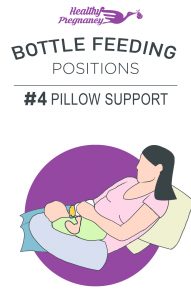 If you want your baby to be comfortable, and want to give your arms a rest, try using a cushion or nursing pillow to position baby in a snug location against your body with their head elevated for support. This bottle-feeding position allows your baby’s head and chest to be properly elevated to eat, while still maintaining a relaxed position.
If you want your baby to be comfortable, and want to give your arms a rest, try using a cushion or nursing pillow to position baby in a snug location against your body with their head elevated for support. This bottle-feeding position allows your baby’s head and chest to be properly elevated to eat, while still maintaining a relaxed position.
Feeding Styles
This type of approach to feeding helps mimic the breastfeeding experience in the sense that it helps encourage baby to take control with recognizing when they want more to eat and when they are feeling full. The purpose of a paced feeding style is to slow down the eating process to make baby use some effort to get additional milk, just as they would during breastfeeding.
To create a paced feeding setup for baby, baby should sit more upright and you tickle baby’s lips with the bottle. Once baby begins to make cues for feeding, place the nipple in baby’s mouth and hold the bottle horizontally and waiting to let the milk reach the nipple of the bottle to mimic the letdown process of breastfeeding. During this type of feeding style, every 20 to 30 seconds, tip the nipple of the bottle upward towards the top of baby’s mouth to stop milk flow before slowly returning the bottle back to a horizonal position. With paced feeding, remember to also switch sides as you would in breastfeeding. Not only is this style of bottle feeding a helpful way to mimic the breastfeeding experience for baby’s feeding habits, it is also a useful option for transitioning from breast to bottle feeding.
A cue-based feeding technique may help provide a more controlled and slower flow rate of milk for baby. To create this type of feeding setup for baby, position baby in a swaddled and elevated side-lying position. The goal for this type of feeding is to minimize the amount of movement of baby and of the bottle nipple in baby’s mouth. This type of feeding relies on watching for cues of hunger, cues of feeding problems (like too fast a flow), and cues of fullness so that baby can choose the pace of which food is supplied and determine when they’ve had enough. This type of feeding style is best for baby’s who are born premature or have feeding difficulties, or for parents who are looking to offer a baby-led way of feeding in which they merely respond to baby’s cues.
Additional Bottle-Feeding Tips
It’s important to learn multiple bottle-feeding positions. It’s equally as important to understand safety precautions to avoid accidents.
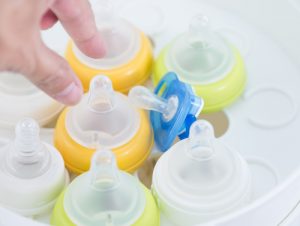 One safety precaution when it comes to bottle feeding is to pay attention to the nipple. Make sure it’s the right shape, especially if you’re transitioning your baby from breast to bottle feeding. Start with a smaller nipple and gradually increase the size. Keep in mind, the flow on the nipple correlates with the size, so adjust it accordingly.
One safety precaution when it comes to bottle feeding is to pay attention to the nipple. Make sure it’s the right shape, especially if you’re transitioning your baby from breast to bottle feeding. Start with a smaller nipple and gradually increase the size. Keep in mind, the flow on the nipple correlates with the size, so adjust it accordingly.
As mentioned above, make sure your baby’s bottle nipple is filled with milk before they begin drinking to avoid an intake of excess air. If baby swallow too much air prior to or during feeding, it can leave baby feeling gassy and increases the chances of acid reflux.
Remember to switch sides. Regardless of whether you are breastfeeding or bottle feeding, switching baby’s feeding habits from one side to another can help prevent your little one from developing a side preference and can help give your arms a break.
When taking a break from feeding or stopping, instead of pulling the bottle away and removing the nipple directly from baby’s mouth, lean the bottle back and point the nipple toward the roof of baby’s mouth so the milk leaves the nipple. This can help ease baby off of feeding without an abrupt stop and can help avoid milk splash.
Burping Tips
Be sure to burp your baby frequently. In fact, you should burp them every two to three ounces of milk. Depending on how much they eat, you can either burp them in the middle of their meal or afterwards. If baby takes in air during a feeding, it can leave them feeling gassy and uncomfortable.
Like feeding positions, there are multiple positions you can use to burp a baby.
Over the Shoulder: For this style, lay your baby over your shoulder as you gently pat or rub their back.
Seated: For this option, sit baby upright and slightly learning forward on their chest against your hand to gently pat their back.
Lying Down: To burp your baby lying down, place baby on their stomach as you rub or pat their back to help them release excess air.
Feeding a baby can be overwhelming, especially for new parents. As long as you take proper safety precautions, feeding your baby is a simple and enjoyable experience. When it comes to bottle-feeding positions, use the one that is most comfortable for you and your baby. Babies eat a lot, especially in the beginning, so mastering any of these techniques is essential to quality feedings and can be incredibly helpful for parents to remain comfortable simultaneously.
Most of all, never leave you baby unattended, even if they’re comfortable holding their own bottle. If you have concerns or difficulties with bottle-feeding, speak to a pediatrician or seek out the assistance of a lactation consultant who can help suggest additional techniques for bottle feeding.


